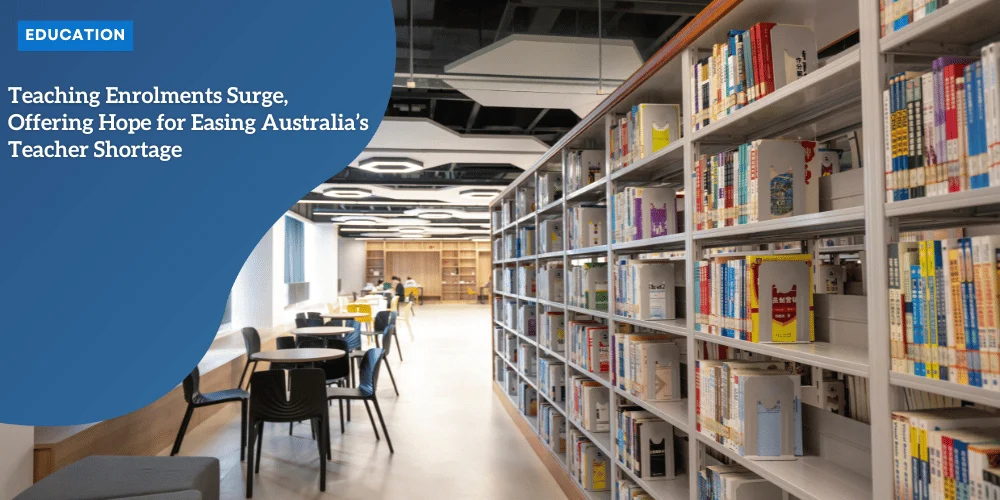Teaching Enrolments Surge, Offering Hope for Easing Australia’s Teacher Shortage

Anúncios
Enrolments in teaching courses at Australian Catholic University (ACU) have seen a significant rise, signaling a potential turnaround in the nation’s ongoing teacher shortage.
At ACU’s Brisbane campus, Semester 1 2025 enrolments in initial teacher education (ITE) programs have increased by 41% compared to the same period last year.
This growth is particularly encouraging, with a 46% rise in First Nations student enrolments and a 16% increase in students from low socioeconomic status (SES) backgrounds.
The data also reveals that nearly 60% of new teaching students at ACU Brisbane achieved an Australian Tertiary Admissions Rank (ATAR) of 75 or above, with 40% scoring 90 or higher.
Anúncios
Additionally, male enrolments have remained steady, and there has been strong interest from students in regional and rural Queensland.
These trends suggest a growing interest in teaching as a career, offering hope for addressing the critical shortage of educators across the country.
A Promising Shift in Teacher Education Enrolments
The surge in teaching enrolments at ACU’s Brisbane campus is a positive development for Australia’s education sector, which has been grappling with a severe teacher shortage for years.
The 41% increase in enrolments for Semester 1 2025 reflects a renewed interest in teaching as a profession, particularly among underrepresented groups.
First Nations students and those from low SES communities are enrolling in teaching courses at higher rates, with a 46% and 16% increase, respectively.
Anúncios
This growth is a testament to the efforts of universities and policymakers to make teaching more accessible and appealing to diverse communities.
The high academic achievements of incoming students further underscore the quality of candidates entering the profession.
With 60% of new enrollees achieving an ATAR of 75 or above, including 40% scoring 90 or higher, the future teaching workforce is poised to bring both passion and academic excellence to classrooms across Australia.
First Nations Students Leading the Way
The significant rise in First Nations student enrolments is a particularly encouraging trend.
Lily McConnell, a proud Aboriginal woman from the Iman mob in Taroom, is one of the many First Nations students embarking on a teaching career at ACU.
“I can’t wait to start,” McConnell told The Educator. “I have always been very passionate about advocating for mental health and the expression of Indigenous culture.”
McConnell’s cultural heritage and personal experiences have deeply influenced her decision to become a teacher.
She is committed to empowering future generations and ensuring that young Aboriginal and Torres Strait Islander students have the opportunity to connect with their culture and community.
“Throughout my schooling, especially over the last three years, I have been inspired by teachers who advocated for me and provided support when I needed it,” McConnell said. “By choosing a teaching degree, I strive to do the same for my future students.”
Supporting Indigenous Students in Higher Education
Kate Mochrie, coordinator of ACU Brisbane’s Indigenous Higher Education Unit Weemala, expressed her enthusiasm for the growing number of First Nations students pursuing teaching careers.
“We are thrilled to see more high-achieving Indigenous students choosing a career where they can make a real difference in the lives of young people and serve as role models for their communities,” Mochrie said.
Weemala, ACU’s dedicated support unit for Indigenous students, plays a crucial role in helping these students achieve their educational goals.
The unit provides academic, cultural, and personal support, ensuring that First Nations students have the resources they need to succeed.
“Weemala is ready to welcome and support our new Indigenous teaching students as they work toward their goals,” Mochrie added.
Addressing the Teacher Shortage Crisis
Australia’s teacher shortage has been a persistent challenge, with many schools struggling to fill vacancies and retain staff.
The surge in teaching enrolments at ACU offers a glimmer of hope, but more work is needed to address the root causes of the shortage.
Factors such as high workloads, burnout, and a lack of support have contributed to the decline in teacher numbers.
However, initiatives aimed at attracting and retaining educators, such as scholarships, mentorship programs, and improved working conditions, are beginning to show results.
The increase in enrolments among students from regional and rural areas is particularly significant, as these communities are often hardest hit by teacher shortages.
By encouraging more aspiring teachers from these areas to pursue education degrees, universities like ACU are helping to ensure that all students, regardless of their location, have access to quality education.

The Role of Universities in Shaping the Future of Education
Universities play a critical role in addressing the teacher shortage by preparing the next generation of educators.
ACU’s focus on diversity, equity, and inclusion has made it a leader in teacher education, attracting students from a wide range of backgrounds.
The university’s commitment to supporting First Nations students and those from low SES communities is particularly noteworthy.
By providing tailored support and fostering a sense of belonging, ACU is helping to create a more diverse and inclusive teaching workforce.
In addition to academic training, ACU emphasizes the importance of practical experience.
Teaching students are given opportunities to work in real classrooms, gaining hands-on experience and building relationships with mentors in the field.
This approach ensures that graduates are well-prepared to meet the challenges of modern education.
The Importance of Male Representation in Teaching
| 📌 Key Aspect | 📝 Description |
|---|---|
| 📈 Stable Male Enrolment | ACU has maintained a consistent number of male students enrolling in teaching programs. |
| 🎯 Workforce Diversity | Encouraging more men to enter teaching helps create a balanced and inclusive workforce. |
| 👨🏫 Male Role Models | Male teachers provide positive role models, particularly for young boys, and help break gender stereotypes. |
| 🏫 Inclusive Education | Maintaining strong male enrolment numbers promotes an inclusive and representative teaching profession. |
Looking Ahead: Building a Sustainable Teaching Workforce
The rise in teaching enrolments at ACU is a promising step toward addressing Australia’s teacher shortage, but sustained efforts are needed to ensure long-term success.
Policymakers, universities, and schools must work together to create an environment where teachers feel valued, supported, and empowered to make a difference.
Initiatives such as increased funding for teacher education, improved working conditions, and targeted support for underrepresented groups will be key to building a sustainable teaching workforce.
By continuing to attract high-achieving and passionate individuals to the profession, Australia can ensure that every student has access to quality education.
Conclusion: A Brighter Future for Australian Education
The surge in teaching enrolments at ACU’s Brisbane campus offers hope for the future of Australian education.
With more students from diverse backgrounds choosing teaching as a career, the profession is becoming more inclusive and representative of the communities it serves.
First Nations students like Lily McConnell are leading the way, demonstrating the power of education to inspire and empower future generations.
With the support of initiatives like Weemala, these students are well-positioned to make a lasting impact in classrooms across the country.
As Australia continues to address its teacher shortage, the growing interest in teaching as a career is a positive sign.
By investing in teacher education and supporting aspiring educators, the nation can build a brighter future for its students and communities.
For more information about teaching programs at ACU, visit their official website or contact their admissions team.






